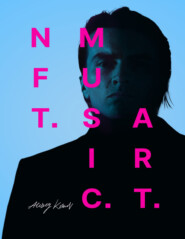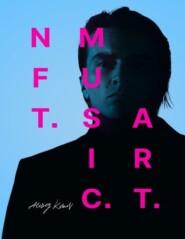По всем вопросам обращайтесь на: info@litportal.ru
(©) 2003-2024.
✖
NFT.MUSIC.ART
Настройки чтения
Размер шрифта
Высота строк
Поля
– image URL pointing to the data
– other random data
These data are called metadata. Smart-contract programming is coded in Solidity language.
Since everything is decentralised, there is no common point where all of it is stored. Smart-contracts cannot be removed and cannot be regulated by anyone or anything.
Where is NFT used?
In chapter 6 of our guidelines we will discuss directions and possibilities for NFT. Let's go through general information, where active work is already underway in cryptospace.
Art
Artists no longer need to rely on gallery or auction houses to sell their art pieces. They can sell their products right to the consumer. This also allows you to get higher income. In addition to this, authors can programm its NFT that way, in which they will get a profit from futher sales to a new owner. This is an advantage, as artists usually never get a profit from futher sales of their product.
Games
Cryptoworld was born from the digital worlds for games. Thanks to NFT, players can monetize their time spent on a game and purchase items with the right of ownership.
Fashion
Digital fashion is just on its rise. World-famous brands auction their own thematic products as NFTs in order to raise money for charity and expand their
audience. Many people introduce the ideas of virtual collections for their avatars.
Music
In cryptoworld musicians can share their music among listeners without intermediaries, conduct a performance for millions of people in the Metaverse with incredible fantastic shows and keep a close contact with the fans.
Influencers
Many celebrities begin to launch their own avatars or sell unique memories, pieces of art and moments in securitized NFTs.
Sport
Sport industry makes tokens out of the best moments of games, videoclips from games or sport inventory as a collectibles.
This is just a small part of NFT potential.
NFT uniqueness
The main value of NFT is that it is a non-interchangeable token. Bitcoin or Ethereum are interchangeable. But there are no two identical NFTs. Even if multiple copies of the same NFT are created, each will be numbered or identified as a unique one in any different way. This makes NFTs collectibles.
Many NFTs are digital understanding of what already exist. For example, videoclips from NBA games, securitized versions of Instagram and many others. But NFTs themselves are one-of-a-kind items, as they have unique IDs.
NFT legal base
Is there any legal protection of NFT?
Yes. Digital and physical assets are protected by NFT ecosystem, thus, allowing to establish clear traceability. Usage of non-interchangeable tokens in blockchain based on smart-contracts makes trading digital materials on the Internet safe and easy.
Legal framework around blockchain and NFT assets is still developing in many countries.
Is there any legal protection of NFT? Yes. Usage of non-interchangeable tokens in blockchain based on smart-contracts makes trading digital materials on the Internet safe and easy.
Chapter 2:
NFT marketplaces
What is an NFT marketplace?
NFT marketplaces are some kind of large internet stores, where people can take a look at an assortment of digital goods and make purchases. Since NFTs are in a blockchain, many of the NFT marketplaces will force you to have a cryptowallet.
NFT marketplaces nominate listed assets in digital currency, but the most widely used is Ethereum. After you bought NFT, ownership passes from the seller to the buyer, who incurs a transaction fee on the Internet.
Cryptoworld is constantly developing and many different marketplaces are opening every day. Many of them will find its own niche in the market. In this guidelines we will take a look at the most popular platforms.
For artists, these platforms are the best at the moment:
Opensea
Rarible
Foundation
Binance
SuperRare
Sotheby's
Let's take a closer look at how it works.
How do NFT trading platforms work?
First of all, you must have a crypto wallet. Even if you have such a wallet, you
have to make sure, that your currency is applicable for NFT. Many marketplaces transfer NFTs in ETH, while others might use Solana (SOL), Tezos (XTZ), FLOW and many other cryptocurrencies.
Marketplaces offer:
● to buy NFT:
Investors can buy NFT via auction or fixed-price listing. After buying, ownership of the NFT will be transferred to the buyer.
● mint NFT:
Many marketplaces allow users to mint their own NFTs. This includes its changing into a digital asset, placed on a blockchain.









